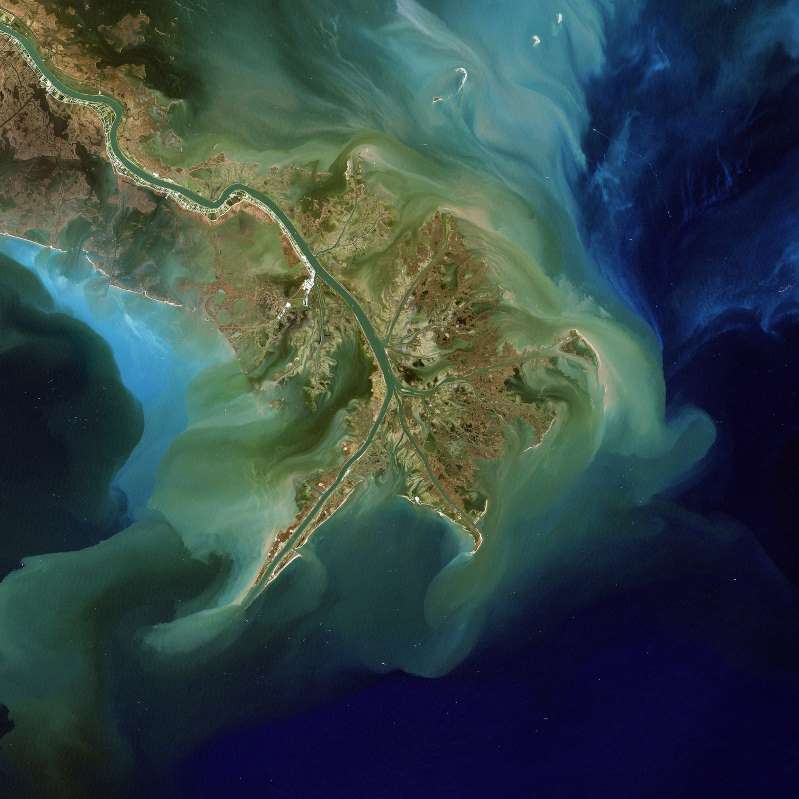
Just off the coast of Louisiana and Texas where the Mississippi River empties, the ocean is dying. The cyclical event known as the dead zone occurs every year, but scientists predict that this year’s could be one of the largest in recorded history.
Annual spring rains wash the nutrients used in fertilizers and sewage into the Mississippi. That fresh water, less dense than ocean water, sits on top of the ocean, preventing oxygen from mixing through the water column. Eventually those freshwater nutrients can spur a burst of algal growth, which consumes oxygen as the plants decompose.
The resulting patch of low-oxygen waters leads to a condition called hypoxia, where animals in the area suffocate and die. Scientists estimate that this year the dead zone in the Gulf of Mexico will spread for just over or just under 8,000 square miles across the continental shelf situated off the coast.
Choking an ecosystem
“When the oxygen is below two parts per million, any shrimp, crabs, and fish that can swim away, will swim away,” says Louisiana State University ocean ecologist Nancy Rabalais. “The animals in the sediment [that can’t swim away] can be close to annihilated.”
Animals like shrimp will often search for more oxygen in shallower waters closer to the shore. Shrimp subjected to hypoxic waters are smaller, their growth stunted by pollution.
One study published in 2017 noted how the dead zone affects Gulf Coast shrimpers by driving down the price of shrimp and reducing profit for local businesses.
Dead zones are not unique to the Gulf of the Mexico, though the gulf’s is estimated to be the world’s second largest. In the world’s largest dead zone, in the Baltic Sea, low oxygen devastated fisheries, and most marine animals can no longer survive there.
Off the West Coast of the United States, California and Oregon crab and oyster industries have reported profit losses since the early 21st century, saying the annual wave of low oxygen ocean water has destroyed many of the animals they normally fish from the sediment.
Dead zone causes
Rabalais says she’s not surprised that this year’s dead zone will be particularly large. Much of the Midwest saw unprecedented rainfall this spring, leading to a large increase in the amount of runoff washing into the sea. Many farmers were so affected by the intense rains that they were unable to plant crops like corn and soybean, meaning all the nitrogen and phosphorus-rich fertilizer they had spread washed into the Mississippi. Scientists are predicting that a warming climate could lead to more extreme rainfall in the region and ultimately make it more difficult to control fertilizer runoff.
“The best way to solve the issue is to limit the nutrients at their source,” says Rabalais. “Once they’re in the river, there’s no good way to reduce them.”
Eugene Turner, also from Louisiana State University, worked with Rabalais on predicting the size of the dead zone. He says better management practices could reduce the size, and suggested maintaining soil health by rotating crops, using less fertilizer, and using crop covers to keep soil in place.
David Scheurer is a scientist from the National Oceanic and Atmospheric Administration who studies dead zones. He notes that it’s difficult to attribute a larger dead zone to just one practice like agricultural runoff, but notes that it plays a significant role in the zone’s formation.
“Scientifically we can reduce the size, but whether you can get there politically, that’s still a work in progress,” he says.
Climate change and dead zones
Scientists are now worried that warming waters in the Gulf of Mexico could increase rates of hypoxia.
“That is a long-term concern,” says Scheurer. “If the climate does change in that region, there is a fair amount of evidence suggesting you would expect things to get worse.”
Simply put, warm water is less capable of carrying oxygen, and a study published last year noted stretches of low-oxygen water thousands of miles across the ocean. Climate change is also expected to cause more intense precipitation and flooding in the Midwest, which will contribute to the amount of chemical fertilizer washed into the ocean.
Both Scheurer and Rabalais, however, say it’s too early to say that the gulf’s dead zone is already being made worse by climate change.
Rabalais says she expects the dead zone to worsen in the future, further harming the ecosystem.
“You of course remember the BP oil spill?” she asks. “This is a slow drip kind of change in the system thats been happening over decades, but it’s just as consequential.”
